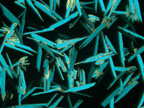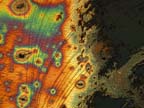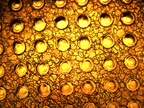|
|
|||
 |
Department of Engineering |
| University of Cambridge > Engineering Department > Photo competition |
 |
Sonja Findeisen-Tandel 'Blue spikes' The photograph shows the growth of a mesophase composed of liquid crystals in a state which is neither crystalline nor liquid, but something in between. Click on the image to see a larger version. |
|
2nd prize |
||
 |
Sam Cocks 'First Light' '15th March 2007. Taken at sunset, this unenhanced photograph captures the first night of power for the secluded Masai village of Essilanke. The village school provided the site for the first trial of a project that I spent three months working on in Kenya: developing a small-scale wind turbine capable of providing a practical solution for electrifying remote regions.' Click on the image to see a larger version. |
|
3rd prize |
||
 |
Ingrid Graz 'Moth' 'My topic is stretchable electronics. I create thin metal films that can be reversibly stretched and remain conductive. PDMS serves as our platform/substrate. PDMS is Polydimethylsiloxane a elastomeric polymer and can be reversibly stretched and comes back to its origninal size and form after stretching. We cast the PDMS into petri dishes by mixing the liquid polymer with a curing agent and after stirring the mixture is curred for 24h at 70 degree Celsius. The image was taken by optical microscope from thin films of PDMS of gold.' Click on the image to see a larger version. |
|
Other entries |
||
 |
Carrie Gillespie 'Beautiful blue phase' A micrograph of one optical texture of a wide temperature range blue phase material. Click on the image to see a larger version. |
|
 |
Chong Cheng Tung and Dr. –Ing. Umesh Bhayaraju 'Firewire' The picture is taken as part of a wider experimental study on Combustion of Bio-fuels. The initial set of experiments includes method to stabilise a Methane flame. The premixed of Methane and Air flows through a circular nozzle. The flame is stabilised by a circular wire. During combustion process the temperatures at the flame reach 2500°C. The flame can be seen in blue shade. The radiance from the combustion products is visible in orange shade. The picture is taken with a Nikon D80 camera, with an 18-200 VR lens. The aperture and the shutter speed are varied depending on the requirements. The concentric bright yellow circles are formed as the wire oscillates due to the instabilities developed in the flow during combustion process. The picture is in its original form. Click on the image to see a larger version. |
|
 |
Timothy D. Wilkinson 'Larger lenses' Larger lens diameter liquid crystal microlenses under polarised illumination. Click on the image to see a larger version. |
|
 |
Robin Firth 'Pouring the Critical Joint' Part IIA bridge project Click on the image to see a larger version. |
|
 |
Rich Wareham 'The surface of a hyper-complex escape-time fractal' Engineers often exploit a mathematical 'trick' for combining two regular numbers into one 'complex' number allowing them to carry twice the information around inside their equations. The behaviour of these complex numbers can be... well... complex. Their ability to produce strikingly detailed images from very simple equations is one observation of the so-called 'Chaos Theory'. In this image we have extended complex number to hold more than just two regular numbers. In this case we are storing four. These 'hyper-complex' numbers can be used to generate fractals just like their regular two-numbered brethren. This image is a visualisation of a three dimensional 'slice' through the four-dimensional surface of one of these hyper-complex fractals generated in real-time via ray-tracing on a consumer-grade graphics card. Click on the image to see a larger version. |
|
 |
Haolan Wang 'Coral' Original black and white SEM image with extra colour enhanced, there are no combinations of images or any further technical treatments on due images. Acknowledgement: I would like to pay my great attitude to Mr. Jon J. Rickard (JJ) from Cavendish Laboratory for his training on SEM and his being ever willing to meet my demands for technique supports during the microscopic examinations." Click on the image to see a larger version. |
|
 |
Sungjune Jung 'Fishtail in the green sea' This image, taken using a Nikon D40X with a 105mm lens and a Xenon flash lamp with ~1us duration, shows one of the flow structures generated from the collision of two impinging jets with radius of 420um. The rapid flash illumination reveals a fish-like formation for dilute polymer fluids: the oval sheet with rims corresponds to the fish head, drops on thin ligaments to its body, and bigger free drops at the end to its tail. The viscoelasticity of the polymer in the fluid resists detachment of the drops from the ligament. This image was adjusted for hue and contrast, and rotated by 90 degrees for effect. Click on the image to see a larger version. |
|
 |
Kun Li 'Laser drilled micro-sized hole array' The photo was taken with optical microscope, no modification is made. Holes were drilled with low power pulsed fibre laser on Stainless Steel at 500kHz repetition rate, it took 0.1 ms (50 pulses) to drill each hole. Each hole is about 30um in diameter, and centre to centre distance is 50um. Click on the image to see a larger version. |
|
 |
Sharvari Dalal 'Crystal Tinsel' The image is an SEM image of ZnO nanowires grown on carbon fibres that has the contrast and brightness adjusted. The image has also been coloured. Each carbon fibre with nanowires is approximately ten microns wide. I acknowledge the help of Dr. Emrah Unalan and Pritiesh Hiralal. Click on the image to see a larger version. |
|
 |
Yun-Thai Li 'Smart Micro-Probe' Raman signal enhancement by Grating-Coupling of Surface Plasmons for Tip enhanced Raman spectroscopy (TERS). Note: Colours are modified in Photoshop. Click on the image to see a larger version. |
|
 |
Sonja Findeisen-Tandel 'Bright orange SmA-Phase' The micrograph show the fan shaped texture from the smectic A phase of a bent-shaped mesogens. Click on the image to see a larger version. |
|
 |
Chong Cheng Tung and Dr. –Ing. Umesh Bhayaraju 'Nebula' The picture is taken as part of a wider experimental study on Combustion of Bio-fuels. The initial set of experiments includes method to stabilise a Methane flame. The premixed of Methane and Air flows through a circular nozzle. A glass plate is mounted flat at 30 mm downstream of the nozzle. The flame is stabilised between the nozzle and the glass. During combustion process the temperatures at the flame reach 2500°C. The flame is visible in circular blue shade. The radiance from the combustion products is visible in pink shade. The picture is taken with a Nikon D80 camera, with an 18-200 VR lens. The aperture and the shutter speed are varied depending on the requirements. The wire is visible in bright yellow. The picture is in its original form. Click on the image to see a larger version. |
|
 |
Chong Cheng Tung and Dr. –Ing. Umesh Bhayaraju 'Supernova' The picture is taken as part of a wider experimental study on Combustion of Bio-fuels. The initial set of experiments includes method to stabilise a Methane flame. The premixed of Methane and Air flows through a circular nozzle. A glass plate is mounted flat at 30 mm downstream of the nozzle. The flame is stabilised between the nozzle and the glass. During combustion process the temperatures at the flame reach 2500°C. The flame is visible in circular blue shade. The radiance from the combustion products is visible in pink shade. The picture is taken with a Nikon D80 camera, with an 18-200 VR lens. The aperture and the shutter speed are varied depending on the requirements. The wire is visible in yellow shade. The bright yellow shade around the wire is due to long exposure. The picture is in its original form. Click on the image to see a larger version. |
|
 |
Sonja Findeisen-Tandel 'Growing of a nematic mesophase' The picture was taken while a nematic phase occurs under the polarizing microscope. Click on the image to see a larger version. |
|
 |
Haolan Wang 'Rainforest' Original black and white SEM image with extra colour enhanced, there are no combinations of images or any further technical treatments on due images. Acknowledgement: "I would like to pay my great attitude to Mr. Jon J. Rickard (JJ) from Cavendish Laboratory for his training on SEM and his being ever willing to meet my demands for technique supports during the microscopic examinations." Click on the image to see a larger version. |
|
 |
A.E. Markaki and J.N. Skepper 'Cartilage cells attaching to Fe-23%Cr fibre network material' cartilage cells attaching to Fe-23%Cr fibre network material Confocal scanning microscopy showing cartilage cells attaching to Fe-23%Cr fibre network material. The cell nuclei are stained orange with Hoechest and the metal fibres are in monochrome. Click on the image to see a larger version. |
|
 |
Sonja Findeisen-Tandel 'Dendritic' The picture was taken on a polarizing microscope on cooling the isotropic liquid of an amide group containing bent core mesogen and shows the mosaic texture of a columnar mesophase. Click on the image to see a larger version. |
|
 |
A. Taylan Cemgil 'First bar of an aria' Computer generated image, representing a multiresolution analysis of tempo (a tempogram) on the first two bars of the Aria, the Goldberg Variations, BWV 988, by J. S. Bach. X axis corresponds to time and Y axis corresponds to tempo. The color gives an indication of the instantaneous tempo of the piece. The metrical hierarchy is clearly visible on this picture. Computer based analysis of musical tempo is a first step in machine listening and plays a key role in music information retrieval and interactive music performance systems. any due acknowledgements: Cemgil, A. T. et. al. On tempo tracking: Tempogram Representation and Kalman filtering. Journal of New Music Research, 2001. Click on the image to see a larger version. |
|
 |
Brendan Baker 'Segrada Familia' A stairwell at Gaudi’s Segrada Familia doubles as a sea shell. The building provides a riveting example of engineering ingenuity (for example, Gaudi observed hanging string arches in a mirror to design arch structures with only compressive loading). The stairs are a glimpse at how natural forms can be used as design inspiration, a strong underlying theme of recent biomimetic approaches to materials and product design. Beauty in elegance, whether a building or engineering solution. Click on the image to see a larger version. |
|
 |
Claire Barlow 'Vibration measurements on the roof of the chapel tower of St John's College' The aim of the measurements was to establish the stiffness of the tower, using accelerometers positioned at different orientations on the tower roof. Excitation was provided by half a dozen people thumping the tower parapet together. Click on the image to see a larger version. |
|
 |
Dave Clarke 'Works Chimney' Taken late evening from the Department's printroom. Click on the image to see a larger version. |
|
 |
Mahalia Miller 'Upwards' This photo is shot looking up through the floors of a 9m concrete and aluminum model of a communications tower. I helped construct this tower as part of the third year Constructionarium project. Click on the image to see a larger version. |
|
 |
Brendan Baker 'Do you feel a breeze?' Engineering for Sustainable Development MPhils Anastasia Kazakova and Tara Shirvani contemplate wind power during a class field trip to Cornwall. Click on the image to see a larger version. |
|
 |
Alan Colli 'Euro-Lithography' Scanning electron microscope image of deep nano-walls etched into a silicon wafer via nanowire lithography. This approach uses bottom-up nanowires as masks to achieve conformal features into underlying films. The nanowire-masks were initially dispersed from solution, and two of them randomly assembled to form the "euro" logo. The symbol was then transferred to the Si wafer by means of deep-reactive-ion-etching (Wall depth ~ 1µm).The image has been colored and edited by Corel Photo Paint. Click on the image to see a larger version. |
|
 |
Ian Howard 'Airpucks' This photo shows a batch of aluminium air pucks before assembly. Three units are used together to build air sleds used in our research into how our brain controls arm movements. An air sled is sometimes needed to constrain the movement of the arm in a plane and supports the weight of the lower arm on a cushion of air. High pressure air is blown through the brass connector and comes out of the air puck through a hole in the base, resulting in a very low friction air bearing. Air pucks built by John Beavis in the Department workshop. Click on the image to see a larger version. Alumni category in the photography competition You may copy an image from the photography competition, reproduce it, and distribute it, but only if you clearly attribute the image to the student or academic who took the photograph, state that they work in the Department of Engineering at the University of Cambridge, and acknowledge Microsoft's sponsorship of the competition. It would also be courteous to provide a links to www.eng.cam.ac.uk and www.microsoft.com. We would be delighted to hear where the images have been used. Please contact marketing@eng.cam.ac.uk to let us know. |
|
Photo Competition Archives |
| All previous year's photos can be found at: www.flickr.com/photos/cambridgeuniversity-engineering 2010 | 2009 | 2008 | 2007 | 2006 | 2005 | 2004 | |
| | Search | CUED | Cambridge University | Privacy policy | |
|
© Department of Engineering at the University of Cambridge Information provided by web-editor |